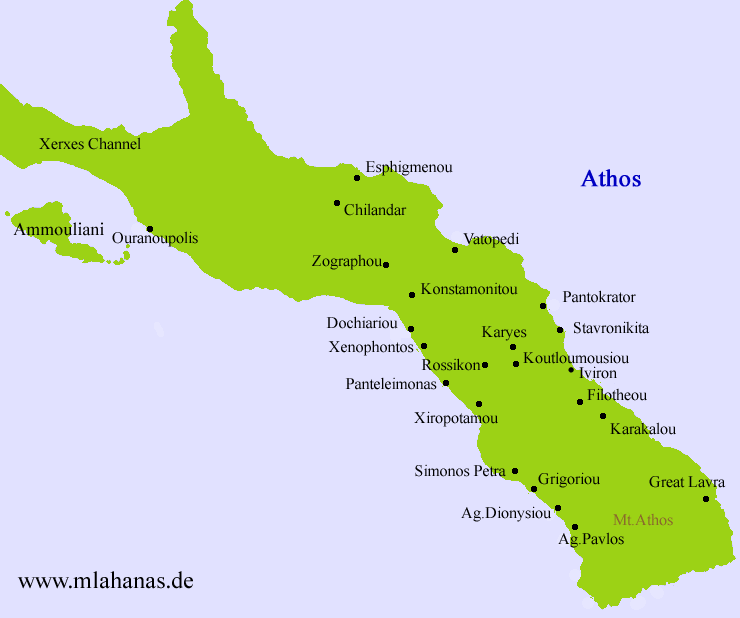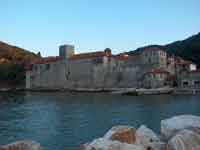|
|

Esphigmenou monastery (Greek: Μονή Εσφιγμένου) is an Eastern Orthodox monastery at the monastic state of Mount Athos in Greece, dedicated to the Ascension of Christ. It is built next to the sea at the northern part of the Athonite peninsula. Located near the Hilandar monastery, it is the northernmost of all Athonite monasteries. The current monastery dates back to the 10th century AD, while tradition holds that the site had been used as a monastery since as early as the 5th century. Esphigmenou ranks eighteenth in the hierarchy of the Athonite monasteries and has since the 1970's been a source of controversy due to conflict with the Ecumenical Patriarchate of Constantinople. It currently holds a brotherhood of approximately 115 monks, which makes Esphigmenou the most populous monastery in Athos.
The monastery's name translates to Greek literally as tightened. There exist conflicting traditions regarding the naming of the monastery. One attributes the name to the fact that the monastery is built on a stretch of land, tightened by three surrounding hills and the sea. Byzantine emperor John Komnenos in his book Proskynetarion tou Agiou Orous tou Athonos (Greek: Προσκυνητάριον του Αγίου Όρους του Άθωνος) describes the monastery thus: It is called "Esphigmenou" because it is restricted by three small mountains, close to the sea. Another tradition attributes the name to the monk that either founded or renovated the monastery. It recounts that he used to wear a tight rope around his waist, therefore the monastery got the name "of the tightened".
Monastery Esphigmenou , Drawing History Athonite tradition attributes the foundation of the monastery to the Byzantine emperor Theodosius II and his sister Pulcheria during the 5th century AD. According to the same tradition this early monastery was destroyed by a huge rock that fell from the nearby hills. According to the same tradition its remains can still be found 500 metres from the existing monastery. Historical and archaeological evidence cannot safely confirm this tradition and therefore the precise time of the monastery's foundation, as well as its founders cannot be positively identified. The evidence can however confirm that as early as the late 10th or early 11th century the monastery existed. It is mentioned in at least three manuscripts. The monastery is referred in a letter by Paul of Xiropotamou dating from 1016. In the will of the monk Demetrius of Chalki, dating from 1030, is signed by a monk who calls himself "Theoktistos monk and abbot of Esphigmenou monastery". Finally, the monastery is mentioned at the second Typicon of Mount Athos in 1046. The monastery greatly prospered until the Ottoman conquest. Many Byzantine emperors, such as John V Palaiologos, contributed to this, as well as leaders of other orthodox states such as Stefan Uroš IV Dušan of Serbia and George, Prince of Rascia. This prosperity was however shrouded by constant disputes over land issues with the neighboring Vatopediou monastery, as well as many pirate raids and two great fires that damaged the monastery during the 14th century. According to manuscripts held in the monastery's collection, the pirates posed a serious threat to the monastery due to the fact that the sea near it is usually calm compared to the seas around the rest of the athonite peninsula. Due to the above reasons the monastery was eventually ruined and practically deserted which allowed the nearby monasteries of Hilandar and Zograf to grab various portions of land from it, which lead to further legal disputes. However the monastery managed to recover eventually, as evidenced by a manuscript dated from 1569 that recounts of 51 monks working for its reestablishment. In 1655 Czar Alexis I of Russia gave the monks permit to travel throughout his lands every 5 years to raise funds for the monastery. During the same period the rulers of the Danubian Principalities also made significant contributions to the monastery. During the early 18th century the bishop Gregory of Melenikon made donations to the it and eventually become one of its monks, undertaking a renovation of the monastery. Also, the bishop Daniel of Thessaloniki took care of the monastery's finances and, with the consent of the Athonite community and Patriarch Gerasimus III of Constantinople, made the monastery a cenobium. The relevant patriarchical edict was published in 1797 by Patriarch Gregory V of Constantinople, who also rebuilt the southern part of the monastery that had been ruined. A series of competent abbots (Acacius, Euthymius, Theodoritus and Agathangellus) greatly renovated and expanded the monastery, to the point that the current structures date almost exclusively from their time. The successor of Agathangellus, Lucas, founded an iconographic school, that greatly served the monastery for an extended period of time. During the Greek War of Independence, the monastery, being the northernmost monastery of the peninsula, suffered gravely from the Ottoman armies that ravaged Mount Athos. However, during this period, it did experience some degree of prosperity.
 |
|
||||||||||||||||||||
|
|

